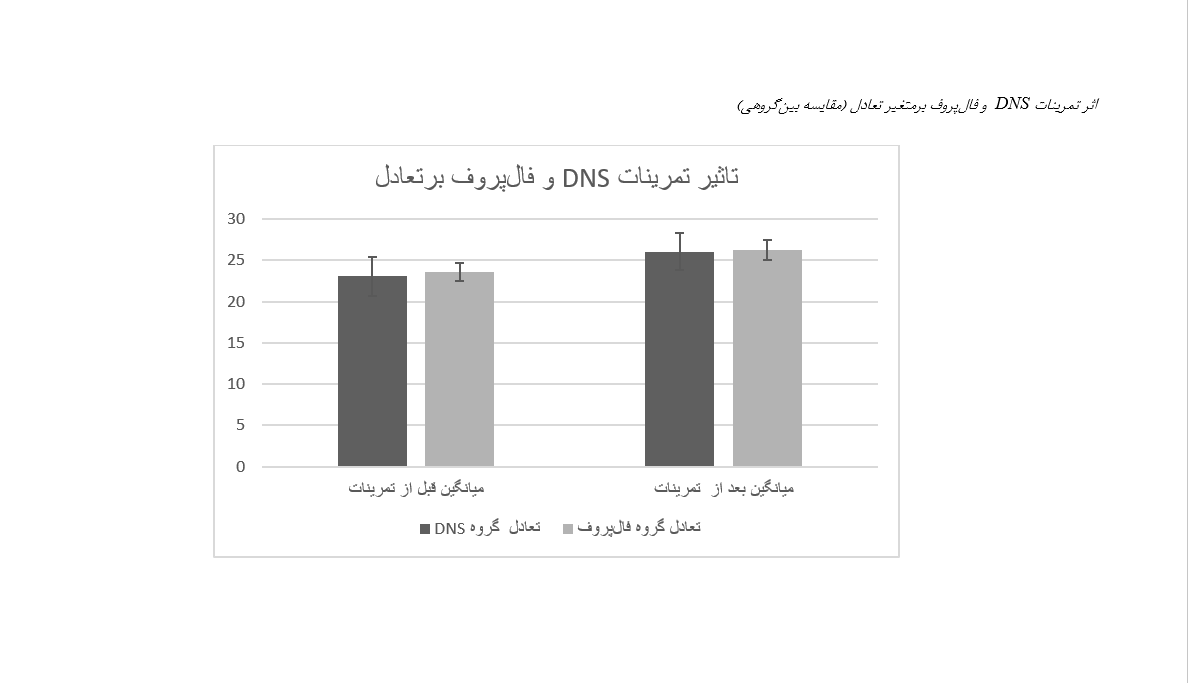The Effects of 12 Sessions of Dynamic Neuromuscular Stabilization and Fall-Proof Exercises on Balance and Motor Performance in Elderly Women with a History of Falls
Keywords:
Dynamic Neuromuscular Stabilization, Fall-Proof, Balance, Motor Performance, FallsAbstract
The aim of this study was to compare the effectiveness of two training approaches—Dynamic Neuromuscular Stabilization (DNS) and the Fall-Proof program—on balance and motor performance in elderly women with a history of falls. In this quasi-experimental study, 35 elderly women aged 60 to 70 years with a history of falling were randomly assigned to one of two training groups: DNS (n = 17) or Fall-Proof (n = 18). The interventions were conducted over four weeks, consisting of 12 training sessions. Balance was assessed using the Mini-BESTest, while motor performance was evaluated through the 30-Second Chair Stand Test (CST) and the 6-Minute Walk Test (6MWT). Data were analyzed using repeated-measures ANOVA, and partial eta squared was used to determine effect sizes. The results showed that both training programs significantly improved balance and motor performance among participants (p < 0.001). However, no statistically significant difference was found between the two groups (p > 0.05). The effect sizes were 0.71 for balance and 0.62 for motor performance, indicating clinically meaningful improvements. These findings suggest that both DNS and Fall-Proof exercises are effective interventions for enhancing balance and motor function in older women with a history of falling. Implementing such programs may help reduce the risk of falls and improve quality of life in this population.
References
Alitabar, A., Mohammad Ali Nasab Firouzjah, E., & Shabani, M. (2023). Comparison of the effect of Otago and Fall proof training programs on balance, ankle proprioception and fear of falling in elderly men with a history of falling. Studies in Sport Medicine, 15(36), 123-146. https://doi.org/10.22089/smj.2023.14494.1670
Alvani, Z., & Saheb Al-Zamani, M. (2020). The effect of Dynamic Neuromuscular Stabilization (DNS) exercises on the dynamic balance and functional disability of athletes with non-specific chronic low back pain. Research in Sports Rehabilitation, 8(15), 127-138. https://rsr.basu.ac.ir/article_3870.html
Batistela, R. A., Rinaldi, N. M., & Moraes, R. (2023). Mini-BESTest cutoff points for classifying fallers and non-fallers female older adults. Brazilian Journal of Motor Behavior, 17(4), 126-133. https://doi.org/10.20338/bjmb.v17i4.354
Beyranvand, R., Sahebozamani, M., Daneshjoo, A., & Seyedjafari, E. (2023). Assessment and comparison the effect of exercise in different depth of water on postural stability and balance recovery strategies of older people: a clinical trial. The Scientific Journal of Rehabilitation Medicine, 11(6), 1002-1015. https://doi.org/10.32598/SJRM.11.6.12
Cheng, D. K., Nelson, M., Brooks, D., & Salbach, N. M. (2020). Validation of stroke-specific protocols for the 10-meter walk test and 6-minute walk test conducted using 15-meter and 30-meter walkways. Topics in stroke rehabilitation, 27(4), 251-261. https://doi.org/10.1080/10749357.2019.1691815
Daneshjoo, A., Sadeghi, H., Yaali, R., & Behm, D. G. (2023). Comparison of unilateral and bilateral strength ratio, strength, and knee proprioception in older male fallers and non-fallers. Experimental Gerontology, 175, 112161. https://doi.org/10.1016/j.exger.2023.112161
Freund, H.-J. (1983). Motor unit and muscle activity in voluntary motor control. Physiological reviews, 63(2), 387-436. https://doi.org/10.1152/physrev.1983.63.2.387
Gill, S., & McBurney, H. (2008). Reliability of performance‐based measures in people awaiting joint replacement surgery of the hip or knee. Physiotherapy Research International, 13(3), 141-152. https://doi.org/10.1002/pri.411
Khazanin, H., Daneshmandi, H., & Fakoor Rashid, H. (2022). Effect of selected fall-proof exercises on fear of falling and quality of life in the elderly. Iranian Journal of Ageing, 16(4), 564-577. https://doi.org/10.32598/sija.2021.3152.1
Kolar, P., Sulc, J., Kyncl, M., Sanda, J., Neuwirth, J., Bokarius, A. V., Kriz, J., & Kobesova, A. (2010). Stabilizing function of the diaphragm: dynamic MRI and synchronized spirometric assessment. Journal of applied physiology, 109(4), 1064-1071. https://doi.org/10.1152/japplphysiol.01216.2009
Magnani, P. E., Genovez, M. B., Porto, J. M., Zanellato, N. F. G., Alvarenga, I. C., Freire Jr, R. C., & de Abreu, D. C. C. (2020). Use of the BESTest and the Mini-BESTest for fall risk prediction in community-dwelling older adults between 60 and 102 years of age. Journal of geriatric physical therapy, 43(4), 179-184. https://doi.org/10.1519/JPT.0000000000000236
Mahshid, F., Zahra, J., Bayan Peymaneh, S., Ghaem Magham Farahani, Z., & Rahgozar, M. (2008). Normalization of the Brief Cognitive Status Examination of the elderly in Tehran (2006). https://icssjournal.ir/browse.php?a_code=A-10-2-401&slc_lang=other&sid=1
Oliveira, J. S., Gilbert, S., Pinheiro, M. B., Tiedemann, A., Macedo, L. B., Maia, L., Kwok, W., Hassett, L., & Sherrington, C. (2023). Effect of sport on health in people aged 60 years and older: a systematic review with meta-analysis. British Journal of Sports Medicine, 57(4), 230-236. https://doi.org/10.1136/bjsports-2022-105820
Orr, R., Raymond, J., & Singh, M. F. (2008). Efficacy of progressive resistance training on balance performance in older adults: a systematic review of randomized controlled trials. Sports medicine, 38, 317-343. https://doi.org/10.2165/00007256-200838050-00002
Peterka, R. J. (2002). Sensorimotor integration in human postural control. Journal of neurophysiology, 88(3), 1097-1118. https://doi.org/10.1152/jn.2002.88.3.1097
Razimoghadam, M., Yaseri, M., Shahali, Z., Fazaeli, A., & Daroudi, R. (2024). The Age and Sex distribution of Hospital Admissions and Hospital Costs with a Focus on the Aging Effect: A Retrospective Analysis of Claims Data. Iranian Journal of Ageing, 18(4), 518-535. https://doi.org/10.21859/sija-1804518
Safari, H., & Zolaktaf, V. (2023). Effects of eight weeks of Dynamic Neuromuscular Stabilization exercises on the balance of older men. The Scientific Journal of Rehabilitation Medicine, 11(6), 978-987. https://doi.org/10.32598/SJRM.11.6.12
Seidler, R. D., Bernard, J. A., Burutolu, T. B., Fling, B. W., Gordon, M. T., Gwin, J. T., Kwak, Y., & Lipps, D. B. (2010). Motor control and aging: links to age-related brain structural, functional, and biochemical effects. Neuroscience & Biobehavioral Reviews, 34(5), 721-733.
Sherrington, C., Fairhall, N., Wallbank, G., Tiedemann, A., Michaleff, Z. A., Howard, K., Clemson, L., Hopewell, S., & Lamb, S. (2020). Exercise for preventing falls in older people living in the community: an abridged Cochrane systematic review. British Journal of Sports Medicine, 54(15), 885-891. https://doi.org/10.1136/bjsports-2019-101516
Sherrington, C., Michaleff, Z. A., Fairhall, N., Paul, S. S., Tiedemann, A., Whitney, J., Cumming, R. G., Herbert, R. D., Close, J. C., & Lord, S. R. (2017). Exercise to prevent falls in older adults: an updated systematic review and meta-analysis. British Journal of Sports Medicine, 51(24), 1750-1758. https://doi.org/10.1136/bjsports-2016-096547
Shumway-Cook, A., & Woollacott, M. H. (2007). Motor control: translating research into clinical practice. Lippincott Williams & Wilkins. https://doi.org/10.1016/j.jpsychores.2007.04.004
Stöckel, T., Wunsch, K., & Hughes, C. M. (2017). Age-related decline in anticipatory motor planning and its relation to cognitive and motor skill proficiency. Frontiers in aging neuroscience, 9, 283. https://pmc.ncbi.nlm.nih.gov/articles/PMC5591340/pdf/fnagi-09-00283.pdf
Takahashi, Y., Saito, K., Matsunaga, T., Iwami, T., Kudo, D., Tate, K., Miyakoshi, N., & Shimada, Y. (2020). Relationship between dynamic trunk balance and the balance evaluation systems test in elderly women. Progress in rehabilitation medicine, 5, 20200004. https://doi.org/10.2490/prm.20200004
Taylor, E. M., Cadwallader, C. J., Curtin, D., Chong, T. T.-J., Hendrikse, J. J., & Coxon, J. P. (2024). High-intensity acute exercise impacts motor learning in healthy older adults. npj Science of Learning, 9(1), 9. https://doi.org/10.1038/s41539-024-00220-2
Tinetti, M. E., Baker, D. I., McAvay, G., Claus, E. B., Garrett, P., Gottschalk, M., Koch, M. L., Trainor, K., & Horwitz, R. I. (1994). A multifactorial intervention to reduce the risk of falling among elderly people living in the community. New England journal of medicine, 331(13), 821-827. https://doi.org/10.1056/nejm199409293311301
Yang, Y.-R., Wang, R.-Y., Lin, K.-H., Chu, M.-Y., & Chan, R.-C. (2006). Task-oriented progressive resistance strength training improves muscle strength and functional performance in individuals with stroke. Clinical rehabilitation, 20(10), 860-870. https://doi.org/10.1177/0269215506070701
Zapparoli, L., Mariano, M., & Paulesu, E. (2022). How the motor system copes with aging: a quantitative meta-analysis of the effect of aging on motor function control. Communications Biology, 5(1), 79. https://doi.org/10.1038/s42003-022-03027-2

Downloads
Published
Submitted
Revised
Accepted
Issue
Section
License
Copyright (c) 2025 فاطمه منصوربهمنی (نویسنده); سعید بحییرایی; عبدالحمید دانشجو (نویسنده)

This work is licensed under a Creative Commons Attribution-NonCommercial 4.0 International License.









